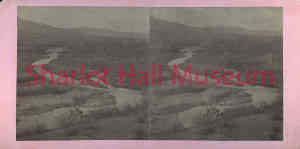By Mick Woodcock
Not all of Arizona’s native fish reach an edible size. A number of varieties only grow to a few inches in length at maturity such as the Virgin spinedace, Lepidomeda mollispinus, as opposed to the Colorado pikeminnow, Ptychocheilus lucius, which can reach a length of six feet. In many historic reports, the word “fish” is used without referencing size or type, so it is difficult to determine much about the original species.
An article in the July 6, 1864 Weekly Arizona Miner is an example of this vagueness. “Lake Carleton is in form or shape an elipse [sic], its dimensions about three-fourths of a mile by one half mile, abounding in duck and fish…” Since there are few natural lakes in Arizona, this is probably what is now called Mormon Lake located southeast of Flagstaff.
 Early reports of fishing come from around the local area, including Williamson Valley, Chino Valley and the Verde River. Some of this was sport fishing, but other newspaper articles refer to fish brought to Prescott in marketable quantities.
Early reports of fishing come from around the local area, including Williamson Valley, Chino Valley and the Verde River. Some of this was sport fishing, but other newspaper articles refer to fish brought to Prescott in marketable quantities.
The Williamson Valley reference is reported in an 1868 edition of the Weekly Arizona Miner, indicating that a group of men cutting hay had caught fish up to a foot long in the lakes there and that there “…are plenty down there.”
Chino Valley is touted as “…a good place to hunt and fish…” according to the Weekly Arizona Miner in 1870. Clerk of the Yavapai County court John Behan and a Mr. Hamilton had gone there for two days and had brought back a buggy filled with “…duck, snipe and fish….”
The Verde River was the largest producer by far because of its size. Two 1867 articles in the Weekly Arizona Miner report “… plenty of fish in its waters…” that were not difficult to catch. Presumably, they were being caught with hook and line as opposed to other methods that would give yields of a commercial size.
 By 1873, there are articles in the local newspaper of loads of fish being brought to Prescott to be sold. “Several hundred pounds of fish were brought here this week from the Rio Verde, and sold at the rate of 50 cents a pound.” “A party came in from the Verde, Thursday noon, with 300 pounds of fish which were sold before dark, at Fort Whipple and in town at 50 cts. Per pound. The fish were caught in a day and a half, with a small seine.”
By 1873, there are articles in the local newspaper of loads of fish being brought to Prescott to be sold. “Several hundred pounds of fish were brought here this week from the Rio Verde, and sold at the rate of 50 cents a pound.” “A party came in from the Verde, Thursday noon, with 300 pounds of fish which were sold before dark, at Fort Whipple and in town at 50 cts. Per pound. The fish were caught in a day and a half, with a small seine.”
Seining was apparently not the only method being employed. An 1879 article reports the following. “Destruction of Fish – We are told by Mr. Ledden, who is plying between the Verde and Prescott, selling all kinds of wild and tame fowls, fish, etc., that great havoc and destruction of fish has been made by people on the Verde by discharging giant powder in the water. He informs us that he has seen several wagon loads dead along the banks of the stream, and that unless this practice is done away with soon, the Verde river will be destitute of the piscatorial tribe. It is altogether too expensive for Arizona.”
In 1878, local businessman W. S. Head is reported to have accompanied a group of men to Oak Creek and that trout fishing was good. These would have been Gila trout, Oncorhynchus gilae, reported to have originally inhabited streams that fed into the Verde River.
About this time in the territory, change was coming to its streams and rivers. We will explore that in the final article on Arizona fishing.
“Days Past” is a collaborative project of the Sharlot Hall Museum and the Prescott Corral of Westerners International (www.prescottcorral.org). This and other Days Past articles are also available at https://www.sharlot.org/articles/days-past-articles.l. The public is encouraged to submit proposed articles and inquiries to dayspast@sharlothallmuseum.org. Please contact SHM Library & Archives reference desk at 928-445-3122 Ext. 2, or via email at archivesrequest@sharlothallmuseum.org for information or assistance with photo requests.


